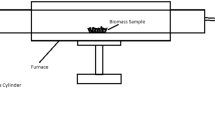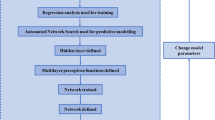Abstract
The rapid growth of the agriculture sector has been facing environmental issues with agriculture waste generation. Agriculture biomass is a good source for biochar production through the pyrolysis process. Biochar is a highly carbonaceous material and has been widely studied on its potential to improve soil quality. It is essential to understand and have a good prediction of biochar quality for biomass pre-screening. The elemental ratios and surface area both play an important role in determining the suitability of biochar as a soil amendment. In this study, a feedforward neural network (FFNN) with a backpropagation algorithm was developed to model the pyrolysis process in predicting the elemental ratios and surface area of various types of biochar using literature data. The O/C and H/C ratio are important parameters in soil quality to determine the stability of biochar in soil. Surface area is equally important to determine the porosity of biochar on its capability to retain water and nutrients. The optimization of the model was done by comparing the algorithm, transfer function, and hidden neurons. The prediction of the elemental ratios and surface area were based on the effect of pyrolysis temperature, heating rate, residence time, ultimate and proximate analysis. It was found that Levenberg–Marquardt backpropagation with ultimate analysis as input variable had the best results in terms of MSE (0.0087 and 0.0278), MAE (0.0594 and 0.0999), MAPE (17.835 and 11.891%), and R2 (0.8601). A validation test was done on the developed model to test its capability to predict the outputs on a wide range of biomass feedstock. The test has shown good alignment with experimental data as a low MSE of 0.0161 is obtained. The model has the capability to achieve high accuracy in prediction with a high overall R2 value and low MSE, MAE, and MAPE.















Similar content being viewed by others
Data Availability
The datasets generated during and/or analyzed during the current study are available from the corresponding author on reasonable request.
References
Albalasmeh, A., Gharaibeh, M. A., Mohawesh, O., Alajlouni, M., Quzaih, M., Masad, M., & El Hanandeh, A. (2020). Characterization and artificial neural networks modelling of methylene blue adsorption of biochar derived from agricultural residues: Effect of biomass type, pyrolysis temperature, particle size. Journal of Saudi Chemical Society, 24(11), 811–823. https://doi.org/10.1016/j.jscs.2020.07.005
Algehyne, E. A., Saeed, T., Ibrahim, M., Berrouk, A. S., & Chu, Y. M. (2021). Investigation of dissimilar laser welding of stainless steel 304 and copper using the artificial neural network model. Journal of Laser Applications, 33(2), 022010. https://doi.org/10.2351/7.0000370
Ali, V., Ibrahim, M., Berrouk, A. S., Algehyne, E. A., Saeed, T., & Chu, Y. M. (2021). Navigating the effect of tungsten oxide nano-powder on ethylene glycol surface tension by artificial neural network and response surface methodology. Powder Technology, 386, 483–490. https://doi.org/10.1016/j.powtec.2021.03.043
Angin, D. (2013). Effect of pyrolysis temperature and heating rate on biochar obtained from pyrolysis of safflower seed press cake. Bioresource Technology, 128, 593–597. https://doi.org/10.1016/j.biortech.2012.10.150
Arumugasamy, S. K., & Selvarajoo, A. (2015). Feedforward neural network modeling of biomass pyrolysis process for biochar production. Chemical Engineering Transactions, 45, 1681–1686. https://doi.org/10.3303/CET1545281
Batista, E. M. C. C., Shultz, J., Matos, T. T. S., Fornari, M. R., Ferreira, T. M., Szpoganicz, B., De Freitas, R. A., & Mangrich, A. S. (2018). Effect of surface and porosity of biochar on water holding capacity aiming indirectly at preservation of the Amazon biome. Scientific Reports, 8(1), 1–9. https://doi.org/10.1038/s41598-018-28794-z
Cantrell, K. B., Hunt, P. G., Uchimiya, M., Novak, J. M., & Ro, K. S. (2012). Impact of pyrolysis temperature and manure source on physicochemical characteristics of biochar. Bioresource Technology, 107, 419–428. https://doi.org/10.1016/j.biortech.2011.11.084
Clarke, S., and Preto, F. (2011). Biomass burn characteristics. Ministry of Agriculture, Food and Rural Affairs, 11, 6. Retrieved from http://www.range-road.ca/Documents/Biomass Burn Characteristics.pdf
Domingues, R. R., Trugilho, P. F., Silva, C. A., Melo, I. C. N. . de, Melo, L. C. ., M.Margriotis, Z., and Sanchez-Monedero, M. A. (2017). Properties of biochar derived from wood and high-nutrient biomasses with the aim of agronomic and environmental benefits. PLoS ONE, 12(5). https://doi.org/10.1371/journal.pone.0176884
Duman, G., Okutucu, C., Ucar, S., Stahl, R., & Yanik, J. (2011). The slow and fast pyrolysis of cherry seed. Bioresource Technology, 102(2), 1869–1878. https://doi.org/10.1016/j.biortech.2010.07.051
Haryati, Z., Loh, S. K., Kong, S. H., Bachmann, R. T., and Cheong, K. Y. (2018). Pilot scale biochar production from palm kernel shell (PKS) in a fixed bed allothermal reactor. Journal of Oil Palm Research, 30(3), 485–494. https://doi.org/10.21894/jopr.2018.0043
Hossain, M. K., Strezov Vladimir, V., Chan, K. Y., Ziolkowski, A., & Nelson, P. F. (2011). Influence of pyrolysis temperature on production and nutrient properties of wastewater sludge biochar. Journal of Environmental Management, 92(1), 223–228. https://doi.org/10.1016/j.jenvman.2010.09.008
Howard, D., and Mark, B. (2004). Neural network toolbox documentation. Neural Network Tool, 846.
Ibrahim, M., Saeed, T., Alshehri, A. M., & Chu, Y. M. (2021a). Using artificial neural networks to predict the rheological behavior of non Newtonian graphene–ethylene glycol nanofluid. Journal of Thermal Analysis and Calorimetry, 145, 1925–1934. https://doi.org/10.1007/s10973-021-10682-w
Ibrahim, M., Saeed, T., Algehyne, E. A., Alsulami, H., & Chu, Y. M. (2021b). Optimization and effect of wall conduction on natural convection in a cavity with constant temperature heat source: Using lattice Boltzmann method and neural network algorithm. Journal of Thermal Analysis and Calorimetry, 144, 2449–2463. https://doi.org/10.1007/s10973-021-10654-0
Kong, S. H., Loh, S. K., Bachmann, R. T., Rahim, S. A., & Salimon, J. (2014). Biochar from oil palm biomass: A review of its potential and challenges. Renewable and Sustainable Energy Reviews, 39, 729–739. https://doi.org/10.1016/j.rser.2014.07.107
Kong, S. H., Loh, S. K., Bachmann, R. T., Zainal, H., and Cheong, K. Y. (2019). Palm kernel shell biochar production, characteristics and carbon sequestration potential. Journal of Oil Palm Research, 31(3), 508–520. https://doi.org/10.21894/jopr.2019.0041
Liao, M., Kelley, SS., Yao, Y. (2019). Artificial neural network based modeling for the prediction of yield and surface area of activated carbon from biomass. Biofuels, Bioproducts and Biorefining 13(4), 1015–1027. https://doi.org/10.1002/bbb.1991
Lavine, B. ., and Blank, T. . (2009). Feed-forward neural networks. Elsevier, 571–585.
Mahidin, M. U. (2020). Selected Agricultural Indicators, Malaysia, 2020. Department of Statistics Malaysia. Retrieved from https://www.dosm.gov.my/v1/index.php?r=column/cthemeByCat&cat=72&bul_id=RXVKUVJ5TitHM0cwYWxlOHcxU3dKdz09&menu_id=Z0VTZGU1UHBUT1VJMFlpaXRRR0xpdz09
Mcfarland, K. (2017). Biomass advantages and disadvantages — SynTech bioenergy. Retrieved from https://www.syntechbioenergy.com/blog/biomass-advantages-disadvantages
Mensah, A. K., and Frimpong, K. A. (2017). Biochar and/or compost applications improve soil properties, growth, and yield of maize grown in acidic rainforest and coastal Savannah soils in Ghana. In Hindawi.
Merdun, H., & Sezgin, I. V. (2018). Modelling of pyrolysis product yields by artificial neural networks. International Journal of Renewable Energy Research, 8(2), 1178–1188.
Mowbot. (2018). Organic fertilizer vs. inorganic. Retrieved from https://www.mowbot.com/blog/organic-fertilizer-vs-inorganic/
Nartey, O. D., and Zhao, B. (2014). Biochar preparation, characterization, and adsorptive capacity and its effect on bioavailability of contaminants: An overview. Advances in Materials Science and Engineering, 715398 | https://doi.org/10.1155/2014/715398
Neoh, J.H., Selvarajoo, A, Arumugasamy, S.K. (2020). Artificial neural network modelling for slow pyrolysis process of biochar from banana peels and its effect on O/C ratio. In: Mat Jizat J.A. et al. (eds) Advances in Robotics, Automation and Data Analytics. iCITES 2020. Advances in Intelligent Systems and Computing, vol 1350. Springer, Cham. https://doi.org/10.1007/978-3-030-70917-4_32
Panchal, F. S., & Panchal, M. (2014). Review on methods of selecting number of hidden nodes in artificial neural network. International Journal of Computer Science and Mobile Computing, 3(11), 455–464.
Piash, M. I., Hossain, M. F., & Zakia, P. (2019). Effect of biochar and fertilizer application on the growth and nutrient accumulation of rice and vegetable in two contrast soils. Acta Scienctific Agriculture, 3(2), 74–83.
Rojas, R. (1996). On the complex backpropagation algorithm. In The Backpropagation Algorithm (Vol. 40, Issue 4, pp. 967–969). Springer-Verlag Berlin Heidelberg. https://doi.org/10.1007/978-3-642-61068-4_7
Selvarajoo, A., Muhammad, D., & Arumugasamy, S. K. (2020). An experimental and modelling approach to produce biochar from banana peels through pyrolysis as potential renewable energy resources. Modeling Earth Systems and Environment, 6, 115–128. https://doi.org/10.1007/s40808-019-00663-2
Stottner, T. (2019). Why data should be normalized before training a neural network. Retrieved from https://towardsdatascience.com/why-data-should-be-normalized-before-training-a-neural-network-c626b7f66c7d
Sun, Y., Liu, L., Wang, Q., Yang, X., & Tu, X. (2016). Pyrolysis products from industrial waste biomass based on a neural network model. Journal of Analytical and Applied Pyrolysis, 120, 94–102. https://doi.org/10.1016/j.jaap.2016.04.013
Tomczyk, A., Sokołowska, Z., & Boguta, P. (2020). Biochar physicochemical properties: Pyrolysis temperature and feedstock kind effects. Reviews in Environmental Science and Biotechnology, 19(1), 191–215. https://doi.org/10.1007/s11157-020-09523-3
Trupiano, D., Cocozza, C., Baronti, S., Amendola, C., Vaccari, F. P., Lustrato, G., Di Lonardo, S., Fantasma, F., Tognetti, R., and Scippa, G. S. (2017). The effects of biochar and its combination with compost on lettuce (Lactuca sativa L.) growth, soil properties, and soil microbial activity and abundance. International Journal of Agronomy, 2017(i). https://doi.org/10.1155/2017/3158207
Voukantsis, D., Karatzas, K., Kukkonen, J., Räsänen, T., Karppinen, A., and Kolehmainen, M. (2011). Intercomparison of air quality data using principal component analysis, and forecasting of PM10 and PM2.5 concentrations using artificial neural networks, in Thessaloniki and Helsinki. Science of the Total Environment, 409(7), 1266–1276. https://doi.org/10.1016/j.scitotenv.2010.12.039
Wijitkosum, S., & Jiwnok, P. (2019). Elemental composition of biochar obtained from agriculturalwaste for soil amendment and carbon sequestration. Applied Sciences (Switzerland), 9(19). https://doi.org/10.3390/app9193980
Willis, M. J., Di Massimo, C., Montague, G. A., Tham, M. T., & Morris, A. J. (1991). Artificial neural networks in process engineering. IEE Proceedings d: Control Theory and Applications, 138(3), 256–266. https://doi.org/10.1049/ip-d.1991.0036
Zafar, S. (2009). BIOMASS PYROLYSIS. Altenergymag. Retrieved from https://www.altenergymag.com/article/2009/02/biomass-pyrolysis/502/
Zhao, S. X., Ta, N., and Wang, X. D. (2017). Effect of temperature on the structural and physicochemical properties of biochar with apple tree branches as feedstock material. Energies, 10(9). https://doi.org/10.3390/en10091293
Zhao, T. H. , Khan, M. I., Chu, Y.M. (2021). Artificial neural networking (ANN) analysis for heat and entropy generation in flow of non-Newtonian fluid between two rotating disks, Math Meth Appl Sci.;1–19. doi/https://doi.org/10.1002/mma.7310
Author information
Authors and Affiliations
Corresponding authors
Ethics declarations
Conflict of Interest
The authors declare no competing interests.
Additional information
Publisher's Note
Springer Nature remains neutral with regard to jurisdictional claims in published maps and institutional affiliations.
Rights and permissions
About this article
Cite this article
Liew, Y.W., Arumugasamy, S.K. & Selvarajoo, A. Potential of Biochar as Soil Amendment: Prediction of Elemental Ratios from Pyrolysis of Agriculture Biomass Using Artificial Neural Network. Water Air Soil Pollut 233, 54 (2022). https://doi.org/10.1007/s11270-022-05510-2
Received:
Accepted:
Published:
DOI: https://doi.org/10.1007/s11270-022-05510-2




